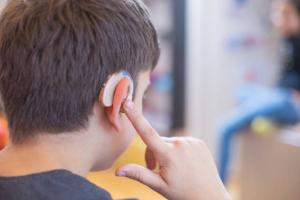School Inclusion of Individuals with Hearing Assistance in Regular Classrooms
Advancing inclusive education for hearing-impaired students through FM and Roger systems, visual supports, and teacher training in mainstream classrooms.
MILPITAS, CA, UNITED STATES, July 8, 2025 /EINPresswire.com/ -- Hearing loss, or auditory impairment, affects the ability to perceive and process sounds, which can directly impact language development, effective communication, and learning in conventional educational settings. Students with hearing loss who use assistive listening devices—such as hearing aids or cochlear implants—require an acoustically favorable environment in order to reach their full academic potential. However, traditional classrooms often present significant barriers, including background noise, suboptimal acoustic conditions, and, in many cases, insufficient teacher training in inclusive-education strategies.Key Elements for School Inclusion
Access to support technologies is essential for students with hearing loss. Assistive listening devices are crucial tools that amplify sounds and improve speech perception, but their effectiveness can be limited in noisy or poorly designed acoustic environments. To mitigate these issues, complementary technologies—such as FM systems and the Roger system—transmit the teacher’s voice directly to the student’s hearing device. This type of technology minimizes the impact of environmental noise, ensuring that the teacher’s message is received clearly and facilitating learning.
In addition to technology, some students with hearing loss require specific curricular accommodations. These may include the use of additional visual materials, real-time transcription, captions on audiovisual presentations, and extended time to complete assignments or assessments. Such measures ensure equitable access to educational content.
Benefits, Challenges, and Recommendations for School Inclusion
School inclusion benefits not only students with hearing loss but also their hearing peers and the educational community as a whole. For students with hearing loss, it represents an invaluable opportunity to develop social, academic, and communication skills in a diverse, inclusive environment. Meanwhile, their peers learn empathy, respect for differences, and enhanced collaborative skills.
However, advances in technology and pedagogy have not eliminated all obstacles. Significant challenges remain, such as lack of access to assistive listening technologies, adapted materials, and proper teacher training. In addition, biases and stereotypes about the abilities of students with hearing loss can limit their full participation in the school environment.
To overcome these barriers, it is essential to:
1. Promote early diagnosis and ongoing audiological monitoring:** Early detection of hearing loss, together with timely interventions, is critical for language development and school readiness.
2. Engage families:** Providing support and training to families enables them to collaborate actively with the school, creating an inclusive and supportive environment.
3. Foster interdisciplinary collaboration:** Professionals such as audiologists, speech-language therapists, teachers, and inclusion specialists must work together to design and implement individualized educational plans that address each student’s unique needs.
If support systems like FM or Roger are not available, it is recommended to seat the child strategically in the classroom where they can see the teacher directly without losing sight. It is important to avoid placing them near walls, to reduce sound reverberation, and away from windows or doors, where sources of noise often occur.
Additionally, maintain good communication with the student by always speaking to them face-to-face and avoiding speaking with your back turned, to facilitate lip reading. It is also crucial to condition the space with materials that absorb sound and reduce reverberation—such as carpets, curtains, or foam or cork panels on walls and floors.
Including students who use hearing assistive devices in regular classrooms is an achievable goal that requires collective commitment, adequate resources, and a proactive attitude from all stakeholders. By ensuring an accessible and favorable educational environment, not only is the life of students with hearing loss transformed, but the entire school community is enriched by fostering diversity and equity. This joint effort builds a future in which differences become opportunities for mutual learning and growth.
Diana Paola Gutiérrez Torres
Diana Paola Gutiérrez Torres
email us here
Legal Disclaimer:
EIN Presswire provides this news content "as is" without warranty of any kind. We do not accept any responsibility or liability for the accuracy, content, images, videos, licenses, completeness, legality, or reliability of the information contained in this article. If you have any complaints or copyright issues related to this article, kindly contact the author above.



